Cover image: Cape Rockjumper by Duncan Butchart – Hermanus, Western Cape – BirdPix No. 86016
Rockjumpers belong to the Family CHAETOPIDAE. The family is endemic to southern Africa and comprises 1 genus and 2 species. Rockjumpers are smallish passerine birds of high mountainous habitats. The genus Chaetops means ‘bristle eye’ which refers to their conspicuous eye lashes. Their taxonomic affinities are uncertain, but research indicates they are most closely related to the Rockfowl (Picatharthidae) of West Africa.
Identification
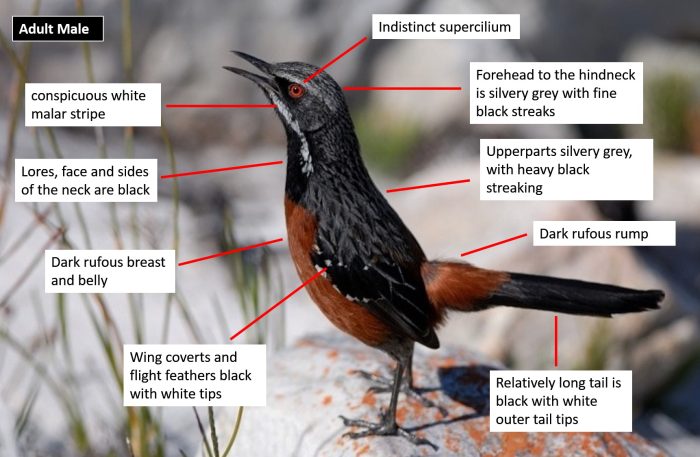
Rooi-Els, Western Cape
Photo by Gerald Wingate
The Cape Rock Jumper is a handsomely plumaged species. In adult males the forehead, crown, ear coverts and hind neck are silvery grey with fine black streaks. The supercilium is silvery-grey and rather indistinct. The lores, face and sides of the neck are black with a conspicuous white malar stripe. The rest of the upper parts, including the mantle, scapulars and back feathers are silvery grey, with heavy black streaking. The rump and upper tail coverts are a rich dark rufous. The relatively long tail is black with white outer tail tips. The chin, throat and upper breast are jet black. The breast and belly are richly coloured in dark rufous, while the vent and thighs are blackish. Under tail coverts black, with whitish tips. The wing coverts and flight feathers are black with white tips. The relatively long legs are an adaptation to bounding around on rocky mountain slopes. The legs and feet are black and the eyes are orange-red.

Rooi-Els, Western Cape
Photo by Johan van Rensburg
Adult females differ from males in having a grey and buff mottled face and neck with an indistinct buff-grey malar stripe. The upper parts are brownish-grey with dark streaks. The rump and upper tail coverts are dark rufous but paler than in males. The tail and wings are brownish black and the flight feathers carry white tips. The breast and belly are dark rufous but duller and paler than in males and the breast shows fine brown streaks. The eyes are reddish-brown..
Juveniles resemble adult females but are less strongly marked overall.

Roodeplaat, Eastern Cape
Photo by Maans Booysen
The Cape Rockjumper most resembles the Drakensberg Rockjumper (Chaetops aurantius) but confusion is unlikely as their distributions do not overlap. Females are similar to female and juvenile Cape Rock Thrush (Monticola rupestris) and Sentinel Rock Thrush (Monticola explorator) but those species have rufous (not black) tails and lack the white outer tail tips.
Status and Distribution
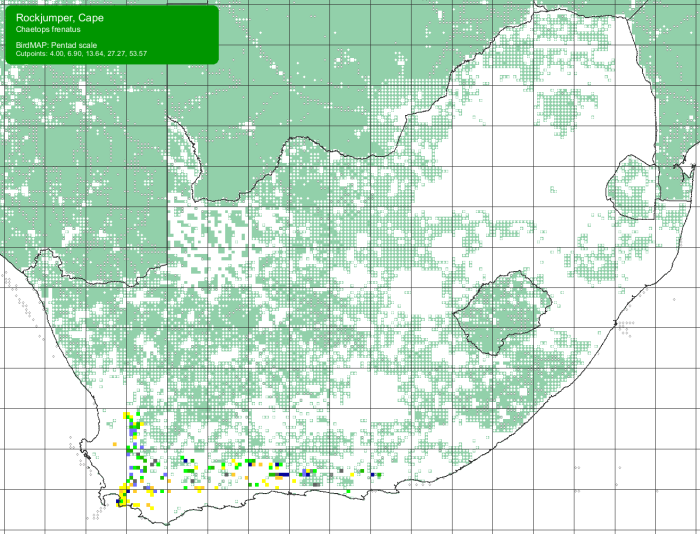
Details for map interpretation can be found here.
The Cape Rockjumper is a locally common resident and is endemic to South Africa. The distribution ranges from Piketberg and the Cederberg Mountains, south to Cape Hangklip near the village of Rooi-Els, Western Cape, and east along the Cape Fold Mountains to Uitenhage, Eastern Cape. The range does not overlap with that of the Drakensberg Rockjumper, but is separated by only 100 km or so.

Groot Winterhoek mountains, Eastern Cape
Photo by Pamela Kleiman
The Cape Rockjumper is near threatened and threats include the rampant spread of alien vegetation.
Habitat
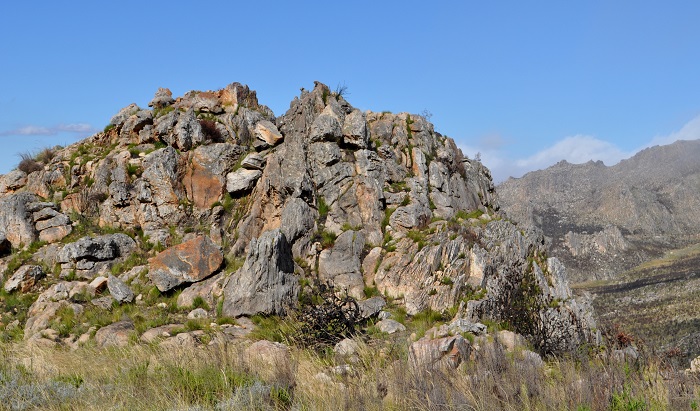
Swartberg Pass, Western Cape
Photo by Ryan Tippett
The Cape Rockjumper inhabits mountain fynbos on windswept, high rocky slopes or ridges. It also occurs down to sea level in the extreme west of its range at Rooi-Els, Western Cape. The Cape Rockjumper is restricted to higher rainfall parts of the Fynbos Biome.

Near Humansdorp, Eastern Cape
Photo by Pamela Kleiman
Behaviour
The Cape Rockjumper is rather poorly known. It is generally a sedentary, resident species, but sometimes moves to lower altitudes in winter.

Roodeplaat, Eastern Cape
Photo by Maans Booysen
Cape Rockjumpers are gregarious and normally encountered in pairs or small family groups. They are unobtrusive and typically scuttle about over and between rocks and boulders. Forages by scratching and probing on the ground, searching in sand and at the base of bushes and boulders. The diet consists mostly of arthropods like caterpillars, beetles, bugs, flies, grasshoppers, spiders, scorpions along with the occasional vertebrate such as small lizards or frogs.

Rooiels, Western Cape
Photo by Georg Jacobs
Cape Rockjumpers are territorial and territories are usually maintained year-round. Boundary disputes are usually brief and involve much calling, chasing and posturing with heads held high and tails fanned to expose conspicuous white tips.

Swartbergpass, Western Cape
Photo by Salome Willemse
The Cape Rockjumper is often a facultative cooperative breeder. A group comprises a monogamous breeding pair and sometimes 1 or 2 additional helpers, often the offspring from the previous breeding season. Helpers assist with nest building, incubation and the rearing of chicks.
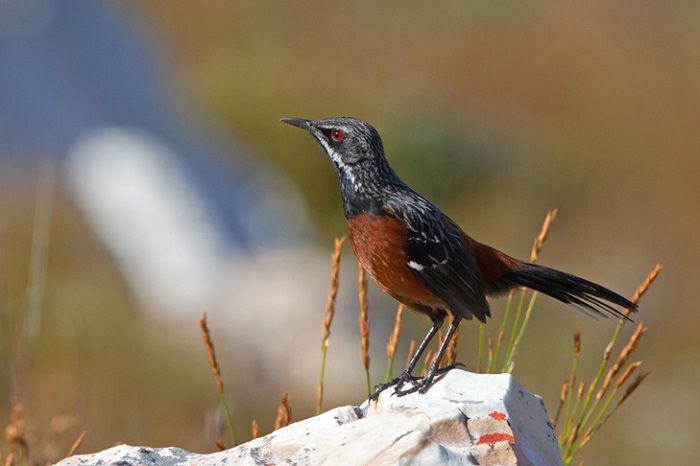
Rooi-Els, Western Cape
Photo by Trevor Hardaker
The nest is a bulky open cup, made from dry grass, twigs, moss and lichen. The bowl is lined with fine plant material and bits of fur. The nest is well hidden and is placed on the ground, usually beneath a rock slab, but sometimes also under a grass tuft, rock overhang or bush. The nest site is chosen on the leeward side of a rock to guard against the prevailing south-east winds.

Rooiels, Western Cape
Photo by Georg Jacobs
Eggs are laid from late July to January with a peak between September and October. Clutches consist of 2 plain white eggs, laid on successive days. Incubation duties are shared by both sexes and probably also helpers. The incubation period lasts up to 21 days and the nestling period takes 18 to 21 days. Young birds are unable to fly for at least 5 days after initially leaving the nest but are able to run well over rocky slopes and hide in crevices or dense vegetation if approached. Both adults and helpers feed the young and remove faecal sacs from the nest.
Cape Rockjumpers are multiple brooded and sometimes attempt to breed up to 3 times in one breeding season.
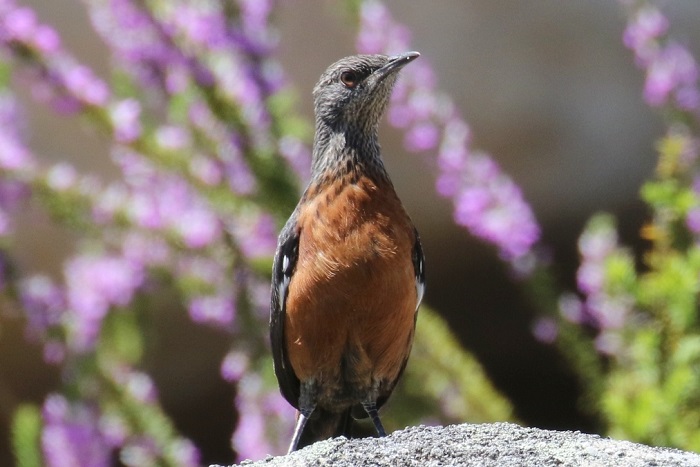
Winterhoek Wilderness Reserve, Western Cape
Photo by Corne Rautenbach
Further Resources
Species text in the first Southern African Bird Atlas Project (SABAP1), 1997.
The use of photographs by Corne Rautenbach, Duncan Butchart, Georg Jacobs, Gerald Wingate, Johan van Rensburg, Maans Booysen, Pamela Kleiman, Salome Willemse and Trevor Hardaker is acknowledged.
Virtual Museum (BirdPix > Search VM > By Scientific or Common Name).
Other common names: Kaapse berglyster (Afrikaans); Sauteur du Cap, Chétopse bridé (French); Kaapse Rotsspringer (Dutch); Kap-Felsenspringer (German); Saxícola-do-Cabo (Portuguese).
List of bird species in this format is available here.
Recommended citation format: Tippett RM 2024. Cape Rockjumper Chaetops frenatus. Biodiversity and Development Institute. Available online at https://thebdi.org/2024/09/01/cape-rockjumper-chaetops-frenatus/
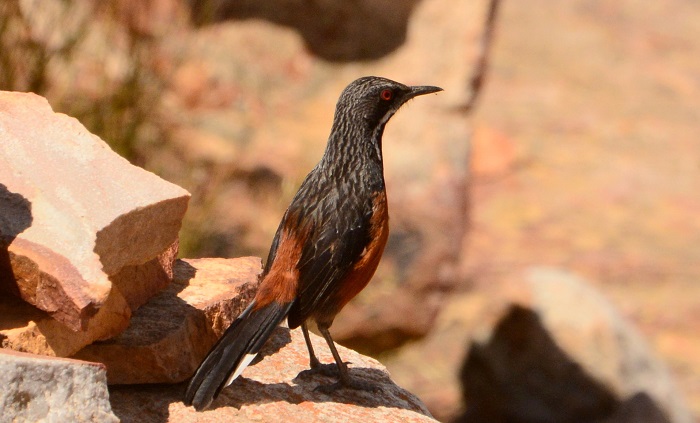
Swartberg Pass, Western Cape
Photo by Ryan Tippett

